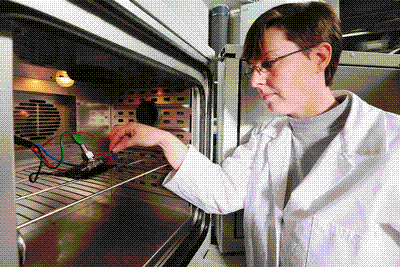Innovative lithium-air batteries will hopefully extend the range of tomorrow’s electrically powered automobiles by several times. The SCHOTT technology group is currently developing an innovative ion-conducting material for this purpose as part of the publicly funded research project GLANZ (“SHINE”), which stands for “anodes and cells protected by glass.”
 New lithium-air batteries could greatly extend the range of tomorrow’s electric cars. SCHOTT is developing an innovative ion-conducting glass-ceramic for this purpose as part of the funded research project GLANZ ("SHINE"), which stands for “anodes and cells protected by glass”. Battery tests are tested inside a climate chamber (see picture) during charging and discharging. Source: SCHOTT
New lithium-air batteries could greatly extend the range of tomorrow’s electric cars. SCHOTT is developing an innovative ion-conducting glass-ceramic for this purpose as part of the funded research project GLANZ ("SHINE"), which stands for “anodes and cells protected by glass”. Battery tests are tested inside a climate chamber (see picture) during charging and discharging. Source: SCHOTT
In the race to develop storage technologies for electric vehicles, a unique new battery is considered to have good chances. So-called lithium-air batteries in commercial form promise to deliver three to five times higher capacities than lithium-ion batteries, for instance. They are expected to achieve an energy density of around 1000 watt hours per kilogram (Wh/kg) and thus considerably greater ranges for electric automobiles.
Exploring the use of this technology in rechargeable storage media that offer reliable performance for long periods of time is the objective of the research project GLANZ that is supported by Germany’s Federal Ministry of Education and Research. Prominent institutes and companies that are partners in this joint project include the Battery Research Center MEET at the University of Münster, the SCHOTT technology group and the industry leaders Rockwood Lithium, Varta Microbattery and Volkswagen AG.
The name of the project GLANZ, which stands for “anodes and cells protected by glass,” points to a core development at SCHOTT: an innovative special material made of glass-ceramic. This glass-ceramic powder with a defined grain size offers high conductivity for lithium ions and outstanding electrochemical resistance. It is bound inside an organic matrix. Together, both elements form a highly stable and dense separator membrane between the two electrodes in the lithium-air battery.
The separator material is intended to enable the battery to operate properly. Inside a lithium-air battery, positively charged lithium ions migrate from the anode (positive electrode) to the cathode (negative electrode) during discharging. At the same time, the remaining free electrons flow to the cathode through an external circuit and bond here with the oxygen and lithium ions. This process is reversed when the battery is charging. During this process, it is important that no undesirable chemical reactions occur due to the fact that these can render the battery unusable after only a few charge-discharge cycles.
The main focus of the development project GLANZ is thus the application-specific encapsulation of the highly reactive lithium-metal anode and creating a model to demonstrate the general feasibility of this approach. “Conducting ions in solid state materials represents an extremely important topic for us both today and in the future, and we're optimistic that we will be able to successfully apply our expertise to a field of application that is completely new for us,” says Dr. Wolfgang Schmidbauer, the project coordinator at SCHOTT. The groundbreaking project is scheduled to run through 2014 and make important progress on the road to more environmentally friendly, resource-saving electric mobility.